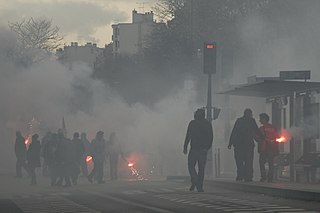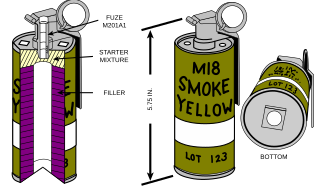
Digital data, in information theory and information systems, is the discrete, discontinuous representation of information or works. Numbers and letters are commonly used representations.

The smoke signal is one of the oldest forms of long-distance communication. It is a form of visual communication used over a long distance. In general smoke signals are used to transmit news, signal danger, or gather people to a common area.

Signal Mountain is a town in Hamilton County, Tennessee, United States. The town is a suburb of Chattanooga and is located on Walden Ridge. "Signal Mountain" is used as a colloquial name for the part of Walden Ridge close to the town. The town population was 7,554 as of the 2010 census and estimated to be 8,567 in 2018.

Brisket is a cut of meat from the breast or lower chest of beef or veal. The beef brisket is one of the nine beef primal cuts, though the definition of the cut differs internationally. The brisket muscles include the superficial and deep pectorals. As cattle do not have collar bones, these muscles support about 60% of the body weight of standing or moving cattle. This requires a significant amount of connective tissue, so the resulting meat must be cooked correctly to tenderise it.

A smoke detector is a device that senses smoke, typically as an indicator of fire. Commercial smoke detectors issue a signal to a fire alarm control panel as part of a fire alarm system, while household smoke detectors, also known as smoke alarms, generally issue an audible or visual alarm from the detector itself or several detectors if there are multiple smoke detectors interlinked.

A smoke grenade is a canister-type grenade used as a signaling device, target or landing zone marking device, or as a screening device for unit movements.

A security alarm is a system designed to detect intrusion – unauthorized entry – into a building or other area such as a home or school. Security alarms are used in residential, commercial, industrial, and military properties for protection against burglary (theft) or property damage, as well as personal protection against intruders. Security alarms in residential areas show a correlation with decreased theft. Car alarms likewise help protect vehicles and their contents. Prisons also use security systems for control of inmates.
Smoke signals are a form of visual communication used over long distances.

Smoke Signals is a Canadian-American independent film released in 1998, directed and co-produced by Chris Eyre and with a screenplay by Sherman Alexie, based on the short story "This is What it Means to Say Phoenix, Arizona" from his book The Lone Ranger and Tonto Fistfight in Heaven (1993). The film won several awards and accolades, and was well received at numerous film festivals.
A false alarm, also called a nuisance alarm, is the deceptive or erroneous report of an emergency, causing unnecessary panic and/or bringing resources to a place where they are not needed. False alarms may occur with residential burglary alarms, smoke detectors, industrial alarms, and in signal detection theory. False alarms have the potential to divert emergency responders away from legitimate emergencies, which could ultimately lead to loss of life. In some cases, repeated false alarms in a certain area may cause occupants to develop alarm fatigue and to start ignoring most alarms, knowing that each time it will probably be false. The activation of false alarms in businesses and schools can lead to serious disciplinary actions and criminal penalties such as fines and jail time.

A hot box is the term used when an axle bearing overheats on a piece of railway rolling stock. The term is derived from the journal-bearing trucks used before the mid-20th century. The axle bearings were housed in a box that used oil-soaked rags or cotton to reduce the friction of the axle against the truck frame. When the oil leaked or dried out, the bearings overheated, often starting a fire that could destroy the entire railroad car if not detected early enough.

A fire alarm system has a number of devices working together to detect and warn people through visual and audio appliances when smoke, fire, carbon monoxide or other emergencies are present. These alarms may be activated automatically from smoke detectors, and heat detectors or may also be activated via manual fire alarm activation devices such as manual call points or pull stations. Alarms can be either motorized bells or wall mountable sounders or horns. They can also be speaker strobes which sound an alarm, followed by a voice evacuation message which warns people inside the building not to use the elevators. Fire alarm sounders can be set to certain frequencies and different tones including low, medium and high, depending on the country and manufacturer of the device. Most fire alarm systems in Europe sound like a siren with alternating frequencies. Fire alarm electronic devices are known as horns in the United States and Canada, and can be either continuous or set to different codes. Fire alarm warning devices can also be set to different volume levels.

A starting pistol or starter pistol is a blank handgun that is fired to start track and field races, as well as competitive swimming races at some meets. Starter guns "cannot fire real ammunition" without first being extensively modified: Blank shells or caps are used to prevent expelling projectiles, and only a small amount of smoke can be seen when shot. In most places, trying to "modify the replica is illegal".

Pilot Peak is the highest mountain in the Pilot Range in extreme eastern Elko County, Nevada, United States. It is the most topographically prominent peak in Elko County and the fourth-most prominent peak in Nevada. The peak is on public land administered by the Bureau of Land Management and thus has no access restrictions.

Lime Point Lighthouse is a lighthouse in California, on the northern side of the narrowest part of Golden Gate strait. The lighthouse sits at the base of a steep cliff, very near the North anchorage of the Golden Gate Bridge. It is built on a 100 ft long rock spur named Lime Point.

The M18 Colored Smoke Grenade is a US Army grenade used as a ground-to-ground or ground-to-air signaling device, a target or landing zone marking device, or a screening device for unit maneuvering.

A lifeboat or liferaft is a small, rigid or inflatable boat carried for emergency evacuation in the event of a disaster aboard a ship. Lifeboat drills are required by law on larger commercial ships. Rafts (liferafts) are also used. In the military, a lifeboat may double as a whaleboat, dinghy, or gig. The ship's tenders of cruise ships often double as lifeboats. Recreational sailors usually carry inflatable liferafts, though a few prefer small proactive lifeboats that are harder to sink and can be sailed to safety.

Nica's Tempo is the most common latter-day title of an album by the Gigi Gryce Orchestra and Quartet, recorded and first released in late 1955. The title track is a reference to Nica de Koenigswarter a.k.a. "The Bebop Baroness" or "The Jazz Baroness", a patron of jazz musicians such as Thelonious Monk and Charlie Parker.

The Kampfpistole or "struggle or combat pistol" in English was a flare gun introduced into German service during 1939 and served throughout World War II.



















